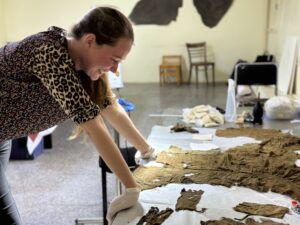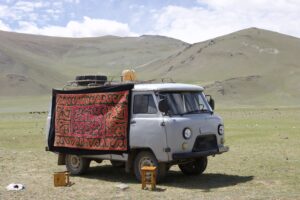Before our upcoming series of posts on the AFCP team’s hands-on work in Mongolia this summer, we’re presenting our final Q and A. Project Leader Colleen O’Shea chatted with Project Fellow Kristen Pearson to learn more about her experiences with archaeology in Mongolia. You can learn more about the AFCP project “Conserving and PreservingMongolia’s Endangered Textile Traditions and Collections” here.
Colleen O’Shea: Alright, let’s start with introductions–where are you from, and where do you live now?
Kristen Pearson: My name is Kristen Pearson, and I grew up mostly in rural Vermont. I went to the University of Pennsylvania for my Bachelor’s degree, and then I lived in Mongolia for a year on a student research Fulbright fellowship. After that, I moved to Cambridge, Massachusetts to start my PhD at Harvard.
CO: What were you doing during the Fulbright year?
KP: I was working on two projects that have both continued in some way to the present day. The first was collections-based research on archaeological textiles excavated in Mongolia, including the textiles from the 10th century rock burial of Üzüür Gyalan, which were excavated by Dr. Mönkhbayar and conserved at the National Center for Cultural Heritage. The second project was inspired by one of the objects in that assemblage—a sheep and goatskin deel. Before coming to Mongolia, I had had training in textile archaeology, but I didn’t know how to approach analyzing a sheepskin object. So I decided to go out and talk with the experts—contemporary herders in Mongolia who make skin objects using many of the same techniques that we see on ancient objects. That fieldwork completely changed the way I saw archaeological skin garments.
CO: So how did you decide to pursue archaeology in Mongolia?
KP: I think there’s a difference between what first drew me to Mongolia and why I stay. It’s hard to articulate why I came here in the first place other than a a deep curiosity that pulled me in this direction. In my Mediterranean archaeology coursework, I found myself writing all my papers on the Scythians…at first I was interested in Greek interactions with nomads, but it quickly turned out I was much more interested in the nomads themselves. My interests kept stretching further and further into Inner Asia. And once I had the opportunity to actually go to Mongolia for the first time in 2017, I bought a one way ticket. I participated in a field school, Dr. Jean-Luc Houle and Dr. J. Bayarsaikhan’s field school in Uvs Aimag. That was the first three weeks, and I ended up staying for the whole summer. I traveled around the countryside quite a bit, and I was able to start working on materials from the Üzüür Gyalan burial, through serendipitous timing and the generosity of my colleagues in Mongolia. Before I left, I was already trying to figure out how I could get back.
Now that I’ve been working in Mongolia for several years, I can tell you there are lots of reasons do research here, both as someone focused on organic material culture and as an archaeologist in general. There aren’t that many places in the world where you can work on well preserved organics. Mongolia is one, Egypt, parts of Scandinavia, Peru. Mongolia really has remarkable preservation conditions for organics, so it’s a really exciting place to work for someone with my specialization.
Secondly, Mongolia is a challenging place to do archaeology. Nomads don’t leave big piles of stuff in nice stratified deposits like sedentary agriculturalist people do, right? Of course, there are walled cities in some periods, there are some settlement sites, campsites that were occupied repeatedly—but they’re hard to find. Even the mortuary record—it’s kind of sparse compared to other places, and that’s what makes it so intellectually stimulating. You can’t be intellectually lazy and be an archaeologist here. You’re dealing with a difficult record to interpret, and I think it drives a lot of creativity in research methods.
CO: So what drew you to archaeological textiles? What do you find especially interesting or informative about them?
KP: There was a textile archaeology course offered by Dr. Anne Tiballi during my freshman year. There were only three or four of us in the class, and we got to study archaeological textiles from the very important Peruvian site of Pachacamac, among others.
For an 18 year old who was fascinated by archaeology, but had never actually handled archaeological artifacts—that was a life-changing experience. I saw how much information could be gleaned from textiles, and that set me on the course that I’m still on.
There are lots of reasons to study textiles. One of them that I find especially powerful is that every single part of the process of making a textile is, for the most part, apparent in a finished object. So, you can look at the level of the fiber and find out how that fiber was produced and harvested. You can look at the level of an individual thread and see exactly how the thread was constructed, even when it’s part of a much more complex object. From Üzüür Gyalan, I worked on a pair of pants made from 26 different pieces of fabric. Every single piece can be investigated independently to learn something about sheep and thread and weaving—and that’s before you get to the object itself as an assemblage of all those fragments.
CO: Apart from the AFCP project, what other research are you working on in Mongolia?
KP: The main thing that I’m working on, other than the AFCP project, is my dissertation research, a big part of which is funded by the Endangered Material Knowledge Program at the British Museum. It’s a project with two different aims: One of them is to document Kazakh hide and fiber craft techniques and object biographies for inclusion in an open-access repository, and the other is to conduct ethnographic research on the role of these craft objects within Kazakh Mongolian households and their extended social networks.
CO: For the object biographies, do you learn that information from interviews with contemporary people?
KP: Yep. So, the approach we’re taking is to produce museum-quality documentation of objects without removing them from people’s homes. These are objects that are in active use. They are in many cases heirloom objects that have a lot of memory and value attached to them. So we visit herder households, bringing the documentation equipment with us. We attached a 3-meter-long wooden plank to our project van and we can use it to hang large felt carpets very efficiently to photograph both sides against a plain backdrop. We interview household members about each object, where it came from, who made it, when they made it, and any family stories about the object that they consider important to record. Often, these objects are gifts linking households across long distances. One of the objects I recorded last year in Nogoonnuur was made by a woman whom I visited this year, in Bulgan.
CO: What are you most looking forward to accomplishing through the AFCP project?
KP: As an archaeologist focused on textiles, I’m really hoping that this project will expand awareness of textiles in the Mongolian archaeological record and just how much information we can get from textiles, even from very small pieces. It’s an important part of conservation, to understand the research value of an object. And it’s important for archaeologists to understand the importance of conservation in order to make that information accessible and help to preserve it.
CO: Alright, lastly, what is one fun fact about you?
KP: Fun fact, hmm…I do a lot of dancing as a hobby. Argentine Tango, West Coast Swing, Blues, Lindy Hop, and most recently Biyelgee!